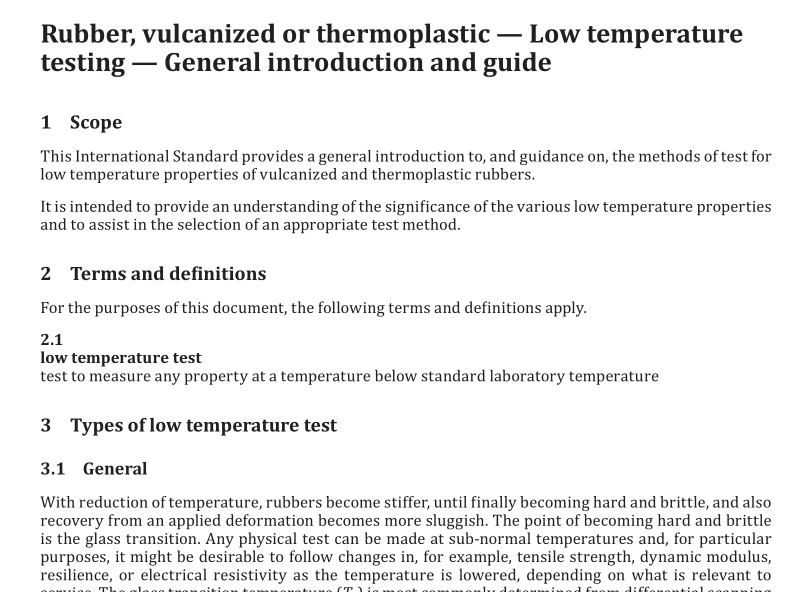ISO 18766 pdf download

ISO 18766 pdf download Rubber, vulcanized or thermoplastic — Low temperature testing — General introduction and guide
1 Scope
This International Standard provides a general introduction to, and guidance on, the methods of test for low temperature properties of vulcanized and thermoplastic rubbers.
It is intended to provide an understanding of the significance of the various low temperature properties and to assist in the selection of an appropriate test method.
2? Terms? and? definitions
For the purposes of this document, the following terms and definitions apply.
2.1
low temperature test
test to measure any property at a temperature below standard laboratory temperature
3 Types of low temperature test
3.1 General
With reduction of temperature, rubbers become stiffer, until finally becoming hard and brittle, and also recovery from an applied deformation becomes more sluggish. The point of becoming hard and brittle is the glass transition. Any physical test can be made at sub-normal temperatures and, for particular purposes, it might be desirable to follow changes in, for example, tensile strength, dynamic modulus, resilience, or electrical resistivity as the temperature is lowered, depending on what is relevant to service. The glass transition temperature (T g ) is most commonly determined from differential scanning calorimetry (DSC) or dynamic thermal mechanical analysis (DTMA) testing. In this respect, it should be noted that the measured T g will depend on the frequency of the test used, a “fast” test yielding a higher T g than a “slow” one. Further information can be found in Reference [6].
Largely for practical convenience, a number of specific low temperature test procedures have evolved for measuring these general trends in behaviour and have been widely standardized.
These low temperature tests can be grouped as follows:
— change in stiffness;
— brittleness point;
— rate of recovery (set and retraction).
In addition, some rubbers, for example natural rubber and polychloroprene, stiffen at low temperatures by partial crystallization. This is a gradual process continuing over many days or weeks and is most rapid at a particular temperature characteristic of each polymer, for example −25 °C for natural rubber. Hence, tests intended to measure the effect of crystallization have to detect changes in stiffness or recovery after periods of “ageing” at a low temperature.
3.2 Change in stiffness
Historically, before the introduction of thermal analysers, it was relatively difficult and expensive to measure tensile or compressive modulus at sub-ambient temperatures. Torsion tests, although rarely used to measure stiffness at ambient temperature, were found to be very convenient for measuring change of stiffness as temperature is lowered. The system standardized for rubber as the Gehman test in ISO 1432 uses a torsion wire to provide the torque to twist a strip test piece. The stiffness is measured as a function of rising temperature. The measurements may be made in a liquid or gaseous environment, either at intervals or with continuous rise of temperature. In principle, these alternatives yield equivalent results.









